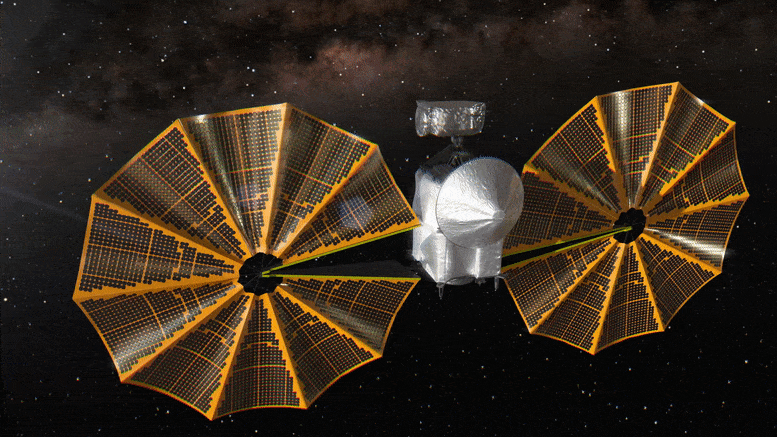
La nave espacial Lucy de la NASA despliega sus paneles solares. Crédito: Centro de Vuelo Espacial Goddard de la NASA
Continúa del 6 de mayo al 16 de junio.[{» attribute=»»>NASA’s Lucy mission team carried out a multi-stage effort intended to further deploy the spacecraft’s unlatched solar array.Throughout the meticulous process, the team commanded the spacecraft to operate the array’s deployment motor for limited periods of time, allowing them to closely monitor the spacecraft’s response.
As a consequence of this work, the mission succeeded in further deploying the array and now estimates that the solar array is between 353 degrees and 357 degrees open (out of 360 total degrees for a fully deployed array). Furthermore, the array is under considerably more tension, giving it substantially more stabilization. Because of this, the mission team is increasingly optimistic the solar array will successfully meet the mission’s requirements in its current tensioned and stabilized state.
For now, further deployment attempts will be paused as the Lucy spacecraft enters a planned period of limited communications. Due to thermal constraints caused by the relative positions of the Earth, spacecraft, and Sun, the spacecraft will be unable to communicate with the Earth via its high-gain antenna for several months. Throughout this period, the spacecraft will use its low-gain antenna remain in contact with Lucy’s ground team.
After its Earth gravity assist maneuver on October 16, the spacecraft will emerge from this partial communications blackout. At that time, the mission team will have more opportunities to attempt further deployment efforts if deemed necessary.
On June 21, the spacecraft successfully carried out a trajectory correction maneuver, which is the second in a series of maneuvers to prepare the spacecraft for its Earth flyby.
Lanzada el 16 de octubre de 2021, Lucy será la primera misión espacial en estudiar asteroides troyanos, una población de pequeños cuerpos que quedaron de la formación del Sistema Solar. En su órbita alrededor del sol, conducen o siguen[{» attribute=»»>Jupiter and may tell us about the origins of organic materials on Earth. Lucy will fly by and carry out remote sensing on six different Trojan asteroids and will investigate surface geology, surface color, and composition, asteroid interiors/bulk properties, and will observe the satellites and rings of the Trojans. Credit: NASA’s Goddard Space Flight Center
También te puede interesar
-
El telescopio espacial Webb de la NASA detecta vapor de agua en la zona de formación de planetas rocosos
-
Una línea escondida en las profundidades del océano divide a los animales en dos campos. Alerta científica:
-
El Telescopio Espacial James Webb detecta agua cerca del centro del disco en formación del planeta
-
La misión de impacto de asteroides de la NASA desencadena una avalancha sorpresa de rocas espaciales. Alerta científica:
-
La armadura secreta de los ratones espinosos africanos